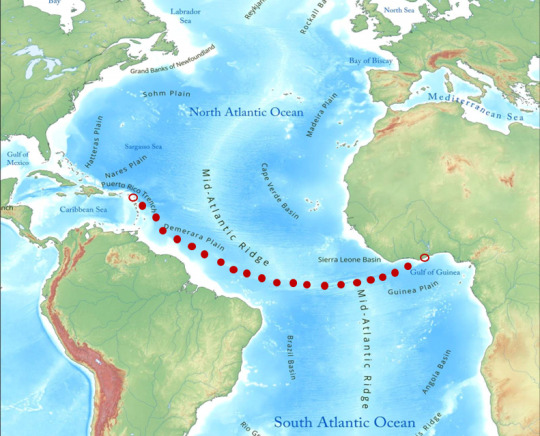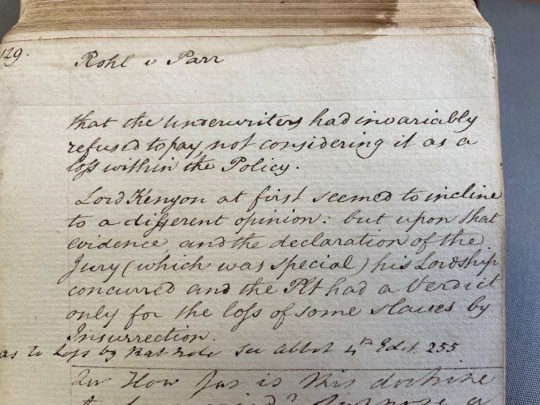#MiddleTempleLibrary
Explore tagged Tumblr posts
Text
Rohl v Parr: A blog post by Middle Temple Library Intern Natasha Southall.
For the past few months I have been transcribing and cataloguing MS17, ‘Cases at Nisi Prius’, containing nominate reports of cases at Nisi Prius. The manuscript belonged to Sir Vicary Gibbs (1751-1820), and may have been written by him. The cases date from the 1760s to 1810s and vary in nature, from libel charges and indictments of fraud, to actions of trover and bills of exchange. I came across several insurance claims for ships that had been damaged at sea. In most of these cases, the contents of the cargo were not specified. One which caught my attention was a case brought by the slaver named Rohl in 1796, where two significant details of the circumstances of the claim are provided: at one point during the voyage there was a slave insurrection, resulting in the death of eight enslaved Africans, and the ship was “destroyed by destructive worms that infest the River of Africa” (folios 128-129). Both factors were integral in determining the success of the insurance claim in court.

1. Rohl’s voyage from Saint Barthélemy to Cape Coast (original map from www.freeworldmaps.net)
On 1st September 1792, the Zumbee sailed from St Bartholomew (Saint Barthélemy) to the River Gombroon on the coast of Africa [1]. Here, it was reported, a slave insurrection resulted in the loss of eight slaves (seven were killed and one died from falling) out of a total of forty-nine. The report claimed that the ship then struggled to get to Cape Coast because the bottom had been “taken by the worm”, likely to be toredo worms/shipworms, which were a common cause of damage to wooden ships in this period. At Cape Coast, the ship was “condemned as irreparable” and sold.

2. Rohl v Parr, folio 128 with ‘worms’ in the margin
The insurance claim was predicated on the policy of damage due to ‘peril at sea’. However, Lord Kenyon and the special jury agreed that the destruction by shipworms, being “an animated substance moving to destroy [the ship]” rather than “an inanimate substance striking against the ship’s bottom”, did not meet the terms of the ‘peril at sea’ policy. Consequently, the counsel for the plaintiff tried instead to recover the partial loss of the enslaved cargo resulting from the slave insurrection. Luckily for Rohl this was granted, as the loss was calculated as more than 5% at the time when the slaves were killed.

3. Figure 2 Rohl v Parr, folio 129
The transatlantic slave trade witnessed the forced transportation of over twelve million enslaved African men, women and children from Africa across the Atlantic to the Americas. Portugal, Brazil, Britain, France, the Netherlands, Spain, Uruguay, the United States of America and Denmark were all involved. One way we are able to catch a glimpse of the mechanisms underpinning the transatlantic slave trade is through legal records like those in the Gibbs manuscript. The records documenting these horrific and treacherous voyages have been made accessible to the public by the SlaveVoyages initiative [2].
This case of Rohl and Parr does not shed much light on the lives of the individuals who were enslaved and travelled on board the Zumbee; the horrors they must have experienced can only be imagined. The case does make clear, however, the financial risks involved for slavers who embarked on the voyage across the Atlantic to Africa. The underlying threat of insurrection was always on the horizon. Yet it would be the workings of the ‘destructive worms’ that rendered slavers like Rohl defenceless both at sea and in the English courtroom.
Citations
[1] Rohl v Parr, Saturday, Feb. 27th 1796, 1ESP.444., Reports of Cases Argued and Ruled at Nisi Prius.
[2] Slave Voyages, https://www.slavevoyages.org/ (last accessed 26/03/2024).
Natasha Southall,
King’s College London
#Africa#black-history#historicaldocuments#history#law#Law library#Library#MiddleTempleLibrary#slave-trade#slavery#transatlantic slave trade
5 notes
·
View notes